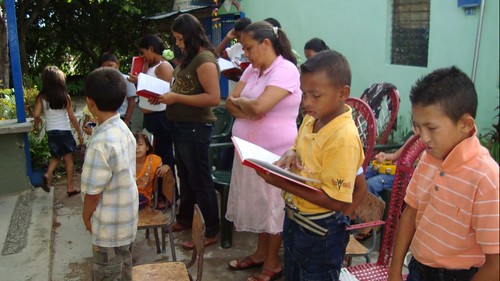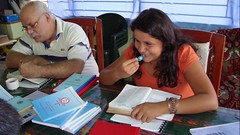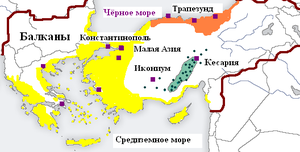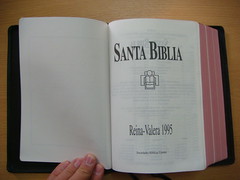
It's "the dog days" of summer for us here. Not that it is much hotter now than other times of the year, the mid-year break for the preschool has slowed the pace of our daily schedule. We had an invitation to organize a vacation Bible school for children in the outlying community of Santa Lucia, but those plans fell through due to circumstances beyond our control. Luz Maria is taking a breather from tutoring children in reading and math. I continue to teach confirmation classes and a course in basic doctrine for those who have been confirmed.
 The course is a regular offering from the Juan de Frias Theological Institute. The student's workbook was developed by former missionaries Paul Brink and James Tino. We have workbooks for all four students, but only copy of the textbook, a Spanish translation of Edward Koehler's "Compendium of Christian Doctrine" by Juan Elias Rubio.
The course is a regular offering from the Juan de Frias Theological Institute. The student's workbook was developed by former missionaries Paul Brink and James Tino. We have workbooks for all four students, but only copy of the textbook, a Spanish translation of Edward Koehler's "Compendium of Christian Doctrine" by Juan Elias Rubio.But I do not have a lot of events to report. We expect this situation to change next month as we anticipate celebrating the rite of confirmation for Angi Perez.
Unsheathing the sword of the Spirit
According to Martin Luther, the original languages of the Old and New Testaments are "the sheath which hides the sword of the Spirit, they are the chest in which this jewel is enclosed, the goblet holding this draught." I am glad of the opportunity to have studied Spanish before undertaking a serious study of New Testament Greek, because Spanish is more like Greek than is English.
 Image via Wikipedia
Image via Wikipedia
For one thing, both Spanish and Greek rely heavily on accent marks. In Spanish, accent marks tell you which syllable of the word you should stress, which is often important as stressing different syllables can change the meaning of a word. Likewise in New Testament Greek, although, as William D. Mounce explains in "Basics of Biblical Greek Grammar", accent marks in Greek are believed originally to have indicated whether you should raise or lower the pitch of your voice on a particular syllable. Everyday conversation in the golden age of ancient Athens probably was more musical than what we are used to nowadays, but by the first century A.D. the accent marks most likely had come to indicate stress rather than pitch.
 Image via Wikipedia
Image via Wikipedia
Because, of course, the Greek of the New Testament is a peculiar dialect known as "koine" or "common" Greek. As Greek became the universal language of the Mediterranean world, it changed in the process from the elegant, highly nuanced language of the classical playwrights, poets and philosophers to a simplified form used on the waterfronts, and in the streets and marketplaces by people who had to learn Greek as a second language. This is a good thing, because the plain language means that New Testament Greek is easier to learn, and the New Testament easier to translate than many classical Greek texts.
In a similar fashion, Venezuelan Spanish is classified as "Caribbean trade Spanish." It is more closely related to the Spanish spoken in Cuba, Puerto Rico and the other islands and coastal regions of the Caribbean basin (where English, French and Dutch are spoken as well) than the Spanish of either the Mexican or Colombian highlands, for example.
Spanish and Greek also are both highly inflected languages, whereas English is not. Inflection means words change form depending on their use in a sentence and their intended meaning. English has some inflection of words. For example, different pronouns (he, she or it) are used to indicate the gender of the subject, or first, second or third person (I, you, he/she/it), or number (we or they).
But in Spanish, the form of the verb also indicates these things, so often you can dispense with pronouns. To say "Who are you?", you can just say "¿Quien eres?" instead of "¿Quien eres tu?" Likewise, in koine Greek, "su grapheis" and "grapheis" both mean "you write." A sentence in Greek and Spanish does not have to have an expressed subject when the verb form gives you your clue, whereas in English, the construction, "Eat dinner", does not give the reader much information to work with.
Word gender is more important in Spanish and Greek than in English. In English, the word "doctor" may refer to either a male or female physician, but in Spanish a woman physician is always "doctora." But even words for inanimate objects will have gender and the assignment of gender may not follow any apparent rhyme or reason.
For example, in Spanish, the word for a woman's gown, whether a bridal or evening gown, is "el vestido", which is masculine in form. On the other hand, a man's neck-tie is "la corbata", which is feminine. Even for living things, the rules for word gender do not always seem consistent. For example, a male cat is "el gato" while a female is "la gata" but a caballo is always a caballo, unless you know the horse is female. then it is a yegua, a word with no masculine form.
As Mounce points out, the New Testament Greek word for sin is hamartia, always female although this in no way implies sin is an exclusively female, while the word for sinner is hamartalos, always male although this never implies only male humans are sinners.
Why is any of this important? Because to preach the Word of God, one must know the ancient tongues as well as "heart language" of the people to whom you are preaching. Languages are not codes, in which there is a one-to-one correspondence between every word and phrase. Every language has unique ways of expressing certain thoughts which may be difficult to clearly translate into another tongue with additional explanation.
Daniel B. Wallace (in Mounce's book) uses the example of John 1:1. Jehovah's Witnesses try to say (as did the Arians in antiquity) it is acceptable to translate this passage as, "In the beginning was the Word, and the Word was with God, and the Word was a god." But the last phrase in Greek is "kai Theos en o Logos." This literally is, "and God was the Word", but the definite article ("the") indicates that "the Word" is the subject of the sentence. That is why the phrase is correctly translated into English as "the Word was God." In Greek, as in Spanish, word order is not critical for correct grammar, but is often used for emphasis. The word order and lack of the definite article before "God" in this verse emphasizes that the Word (who will later be identified as Jesus Christ) shares all the attributes of "God", but also that there is at least one other, distinct person who is also "God." The Trinitarian implication is clearer in the original Greek than in English or Spanish translations. The only way you could get "and the Word was a god" out of this verse would be if were written, "kai o Logos en Theos."
The Reina-Valera Bible tries to make this a little plainer by translating John 1:1 in this way:
"En el principio era el Verbo, y el Verbo era con Dios, y el Verbo era Dios."
Usually the word for "word" in Spanish is "la palabra", as in "la Biblia es la Palabra de Dios" ("The Bible is the Word of God"). "Verbo" normally means the same as the English "verb" (action or state-of-being word), but the Latin root of both is "verbum", which originally meant "word." "Verbal", that is "relating to words" especially the spoken word, means the same in Spanish and English, and the Spanish "verboso" and English "verbose" both mean "wordy."
Why does the Reina-Valera Bible use "verbo" instead of "palabra"? For one thing, "palabra" is feminine while "verbo", like the Greek word, "logos", is masculine. There is more than some concern for grammatical consistency here, because the "Logos" is both identified with God (Who reveals Himself in masculine terms) and with a man, that is, Jesus Christ. The Logos is not just a what, but also a who.
But what is the Logos? is no small question in itself. The term, "logos" signifies much more than "word", as in a combination of letters or sounds. It was a term with long history in Greek philosophy and Hellenistic Judaism. For the Greeks, the Logos was the mediating principle between an entirely transcendent and holy Supreme Being and an impure and imperfect material world. For the Greek-speaking Jews, the Logos was both the first thought or idea engendered in the mind of God before the creation, a perfect reflection or expression of the nature and will of God, and thus also the instrument by which the world was created.
This is why John writes, "All things were made through Him, and without Him, nothing was made that was made." In the first chapter of Genesis, God (the Father) whose Spirit moved over the face of the waters, called all things into existence just by "saying the word." But the Word was not a magic sound, as such, but the direct expression of God's will. So the Word was present in the beginning with the Father and the Spirit and was the instrument by which the world was created. Later the Word made flesh as Jesus Christ would become the only instrument by which sinful human beings might come to know both the Father and the Spirit.
Why I like the Reina-Valera
 Image by J. Mark Bertrand via Flickr
Image by J. Mark Bertrand via Flickr
While there are, I believe, more than half a dozen different Spanish translations of the Bible, but our choice in Venezuela usually boils comes down to two: The Reina-Valera Bible, 1960 revision, and "Dios Habla Hoy", a translation in more "contemporary" Spanish, also known as the "Version Popular".
This is because both of these translations are published and distributed widely by the United Bible Societies, the international arm of the organization that provides with the Gideon's Bible in your hotel room. "Dios Habla Hoy" is translation that was specially commissioned by the United Bible Societies. I prefer the Reina-Valera. Here is why:
T
 he arguments against using the Reina-Valera Bible are quite similar to those used against the King James Bible. The first argument is that the Spanish of the Reina-Valera is archaic and difficult for the average Latin American to understand. The Reina-Valera Bible, first published in 1569, was the first printed translation of the entire Bible in Spanish. Just to be clear on this point, there were translations of the Bible into Spanish, English and other languages before the Reformation, but "before the Reformation" also means "before the invention of Gutenberg's moveable-type printing press", so copies of these translations were never widely distributed. Only passages from the Vulgate, a fifth-century Latin translation, were used in medieval church liturgies.
he arguments against using the Reina-Valera Bible are quite similar to those used against the King James Bible. The first argument is that the Spanish of the Reina-Valera is archaic and difficult for the average Latin American to understand. The Reina-Valera Bible, first published in 1569, was the first printed translation of the entire Bible in Spanish. Just to be clear on this point, there were translations of the Bible into Spanish, English and other languages before the Reformation, but "before the Reformation" also means "before the invention of Gutenberg's moveable-type printing press", so copies of these translations were never widely distributed. Only passages from the Vulgate, a fifth-century Latin translation, were used in medieval church liturgies.The original 1569 edition became known as "the Bible of the Bear" because the frontispiece depicted a bear delving into a honeycomb (the honeycomb being the hidden treasure of the Gospel). Casiodoro de Reina was the primary translator of this Bible. A second edition was published in 1602, with minor revisions by another former monk, Cypriano de Valera. This became the definitive text, thus the translation is known as the Reina-Valera Bible.
The Reina-Valera version has been revised a number of times in an effort to modernize its Spanish, the most recent being in 2004 by Dr. Humberto Gomez. The 1960 revision by the United Bible Societies, at the time the first revision in 51 years, established the Reina-Valera Bible as the most widely distributed and respected version of the Bible in Latin America. So the answer to the first objection is this: 400 years after its first publication, Biblia de Casiodoro de Reinamore than 20 million copies of the Reina-Valera Bible are distributed every year across Latin America.
The second argument against using the Reina-Valera Bible is this: Textual scholarship has moved on since the 1600s. The "first editions" of the inspired books, of course, no longer exist, and they did not exist in the time of the Reformation either. The Greek and Hebrew texts used for Bible translation are the result of comparison and collating of manuscript copies that have been passed down to us.
The Old Testament of the Reina-Valera Bible, like the King James Bible and Luther's German Bible, is based on the first printed version of the Masoretic Text, published by Daniel Bomberg and Jacob ben Chayyin in 1525, which in turn was based on the Aleppo Codex, then believed to be the oldest complete manuscript copy of the Old Testament and still considered the most authoritative.
The discovery of the Dead Sea Scrolls between 1947 and 1956 revealed older copies of some Old Testament books, but with only minor variations from the Masoretic Text. Jews to this day consider the Masoretic Text to be the standard for their sacred scriptures.
The New Testament is a more fertile field for discussion, and even controversy. This is because New Testament scholars suffer from an embarrassment of riches. There are thousands of manuscript copies of the New Testament, more than any other ancient work. All of these manuscripts have slight variations in wording and in some cases are not complete.
The translations of the New Testament by Luther, William Tyndale and Reina are based on the Textus Receptus, a redaction by Desiderius Erasmus of a collection of manuscripts dating from as early as the fifth century A.D. and used throughout the Eastern Orthodox, or Byzantine Church. The Textus Receptus was used not only in making the great translations of the Reformation, but also in older translations approved by the Roman Catholic Church, such as the Douay-Rheims English Bible. However, later scholars have argued that Erasmus' work was lacking in some respects (for some parts of the New Testament he did not compare multiple manuscripts and for others did not translate directly from the Greek, but relied on the Latin Vulgate). It is believed that Erasmus, a brilliant scholar, was pressured by his publisher into finishing his revision of the Greek text as quickly as possible in order to take advantage of market demand.
Many additional manuscript copies of the New Testament were discovered in the late 19th and early 20th centuries, many of which date to the second to fourth centuries A.D. Contemporary scholars especially place great store in the Codex Vaticanus and Codex Sinaiticus, believed to be the oldest existing manuscript copies of the entire Bible in Greek. Most recent translations of the Bible rely mainly on these older, believed to be more authoritative texts.
However, the textual differences between the existing manuscripts amount to trivial differences in wording that do not alter the meaning of the text in any way. The argument is that the discovery of older, allegedly more authoritative manuscripts may refine our understanding of certain Scripture passages and prevent misinterpretation.
For example, according to the King James Bible, in Luke 2:14, the angels announce to the shepherds, "Peace on earth, good will toward men." Verlyn Verbrugge (in Mounce's book) says this is an acceptable translation according to the manuscripts used to translate the KJV, because they use eudokia ("good will" in the nominative case), whereas the older manuscripts use eudokias ("good will" in the genitive case). Contemporary translations will render this verse as something like, "Peace on earth toward men of good will" or the also acceptable "Peace on earth toward men on whom God's favor rests."
This is reflected in the Spanish translations as well, for the Reina-Valera translates the phrase as "Y en la tierra paz, buena voluntad para con los hombres," while Dios Habla Hoy reads, "Paz en la tierra entre los hombres que gozan de su favor."
The thought is the first version may be incorrectly understood as the announcement of the end of political strife in our fallen world. Picture a newscaster reporting from some hot spot in the Middle East in early winter, gazing portentously into the camera and saying, "As Christians all over the world prepare to celebrate the birth of one who 2,000 years ago promised peace on earth, the realization of that ideal seems more distant than ever."
The second phrasing perhaps more clearly captures the meaning of the Gospel: Christ will bring peace (reconciliation) with God to those who are willing to believe in Him.
Nevertheless, I have made my crude effort to compare passages from the Reina-Valera and Dios Habla Hoy side-by-side with the Greek New Testament that I have. Which, by the way, is also published by the United Bible Societies (they're everywhere! theyŕe everywhere!) and has notes indicating the more striking differences between the different manuscripts. i have gotten the impression that the Reina-Valera more consistently sticks to a precise translation of the Greek text, whereas the translators of Dios Habla Hoy felt freer to paraphrase. Again, the differences are not world-shaking, not worth telling anyone not to use Dios Habla Hoy, but enough for me to feel more confidence in the Reina-Valera Bible.
Luther's German Bible shaped the development of the modern German language and German literature. The King James Bible had much the same impact on English literature. One can't help but wonder why no contemporary translation of equivalent stature has emerged, despite years of progress in historical and linguistic research. I think one reason is because the translators of the Reformation era did more with the materials that they had, because it was more than an academic exercise to them.
George Bernard Shaw (of all people!) wrote of the King James Bible: "The translation was extraordinarily well done because to the translators what they were translating was not merely a curious collection of ancient books written by different authors in different stages of culture, but the Word of God revealed through His chosen and expressly inspired scribes. In this conviction they carried out their work with boundless reverence and care and achieved a beautifully artistic result."
Much the same could be said of the Reina-Valera Bible, especially when you know the story of its primary translator.
Casiodoro de Reina, Spanish Reformer
 Image via Wikipedia
Image via Wikipedia
There is a good biography of Casiodoro de Reina, written by Raymond S. Rosales and published by Concordia Publishing House: Casiodoro De Reina, Patriarca Del Protestantismo Hispano. As the title should warn you, it is in Spanish. There is also an English-language biography by Arthur Gordon Kinder, Casiodoro de Reina: Spanish reformer of the sixteenth century.
Casiodoro de Reina was born in 1529 in Montemolin, Spain. He studied Latin, Hebrew, Greek and theology at the University of Seville before joining the Order of St. Jerome and entering the monastery of St. Isidoro del Campo near the city of Seville. After reading the works of Martin Luther, he became convinced of the truths of sola Scriptura, sola gratia and sola fides. Many of his brothers in the monastery listened and also believed. For this the Spanish Inquisition labeled Reina not only a heretic, but a "heresiarch", meaning he was on their equivalent of a "Ten Most Wanted" lists.
Reina fled Seville in 1557 and found refuge in Geneva, Switzerland, thanks to followers of John Calvin. At first he associated himself with Calvin's movement, but Reina's understanding of the sacraments was always closer to the Lutheran position.
Also, he made enemies for himself among the Calvinists by speaking out against the burning at stake of his fellow Spaniard, Dr. Michael Servetus (or Miguel Serveto). Servetus, a brilliant physician, was the first European to observe and describe the human circulatory system. He also came to reject the doctrine of the Trinity, for which modern-day Unitarians hail him as a hero. However, the religious viewpoint of Servetus in contemporary terms actually was closer to that of the Jehovah's Witnesses, Oneness Pentecostals and other "non-trinitarian fundamentalists." Servetus not only held to radical ideas, he also had the type of personality that antagonized most people with whom he came in contact. His relationship with John Calvin was particularly rancorous, on a very personal level, and Calvin used his influence with the Geneva city council to have the council condemn Servetus to death.
Reina was much more orthodox than Servetus, but believed that since genuine faith was the work of the Holy Spirit and could not be spread by the sword, the civil government should tolerate differences of religious opinion. He soon left Geneva, but not before beginning the translation of the Bible into Spanish with the help of other former monks from the Spanish monastery who had found refuge there.
From Geneva, Reina traveled to London in 1557. He would move frequently for many years because of continued pursuit by agents of the Inquisition and persecution by his enemies among the Calvinists. While living in London, Reina married Anna, a Dutch widow. In 1562, he was burned in effigy (that is, by proxy) by the Inquisition in Seville, Spain.
In 1563, Reina and his wife moved from London to Amsterdam. In 1564 they moved to Frankfurt, Germany, then in years following to Strasbourg, France, then Basel, Switzerland, then back to Frankfort. During this period, de Reina continued to work on his translation of the Bible, and to serve as the pastor of independent evangelical congregations of expatriate Spaniards, Italians and Frenchmen (for he spoke all three languages). Also, he and Anna had five children.
In 1579, Reina publicly signed his subscription to the Augsburg Confession and was installed as pastor of the Evangelical Church of the Augsburg Confession, a congregation of French-speaking Lutherans in Amsterdam. He wrote a guide to the Lutheran liturgy in French for this group.
Finally, in 1585, Reina returned to Frankfort with some of his French and Dutch members from Amsterdam to establish a Lutheran congregation for refugees from religisous persecution in France and what is now the Netherlands, Belgium and Luxembourg. He served as pastor of this church until his death in 1594. His wife, Anna, died in 1612.
Casiodoro de Reina considered himself a Spaniard until the day he died, although he lived most of his life in exile from his native land. Thanks be to God for blessing his efforts to produce an enduring translation of the Bible for the Spanish-speaking world.
![Reblog this post [with Zemanta]](http://img.zemanta.com/reblog_e.png?x-id=1c1c4f23-882c-47f2-80e6-9dd6c2bef20e)
No comments:
Post a Comment